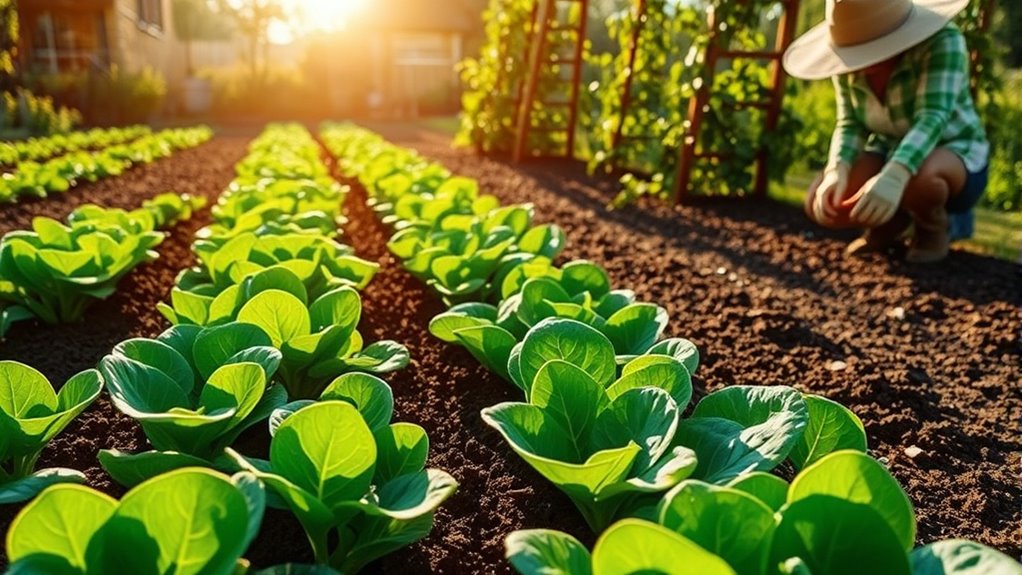To grow thriving spinach, I focus on seed selection, like heirloom varieties and organic options. I make certain to plant in well-drained, loamy soil with full sun, aiming for a pH between 6.0 and 7.0. Regular watering at 1 to 1.5 inches weekly keeps the soil moist without waterlogging. I also practice succession planting every few weeks and watch for pests to guarantee healthy growth. There’s so much more to reflect on for a successful garden!
Key Takeaways
- Select high-germination seed varieties like Bloomsdale and Viroflay for optimal growth and adaptability to local conditions.
- Ensure well-drained, fertile loam soil with a pH between 6.0 and 7.0 for nutrient availability and healthy spinach plants.
- Practice succession planting every 2-3 weeks to ensure a continuous harvest throughout the growing season.
- Implement drip irrigation to provide consistent moisture directly to the root zone, preventing waterlogging and promoting healthy growth.
- Regularly monitor for pests and diseases, utilizing crop rotation and sanitation measures to ensure plant health and productivity.
Organic Spinach Seeds (Bloomsdale Long Standing) – Approx 300 Seeds
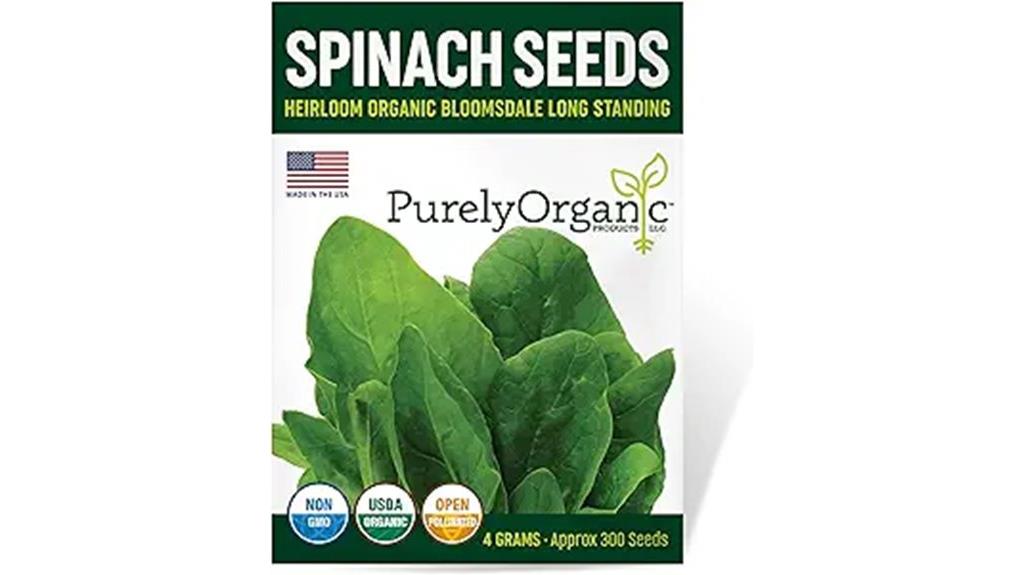
If you’re looking for a reliable and flavorful spinach variety, the Organic Spinach Seeds (Bloomsdale Long Standing) are an excellent choice for home gardeners and culinary enthusiasts alike. With approximately 300 seeds per packet, you’ll have plenty to sow in your garden. These USDA certified organic, non-GMO, heirloom seeds produce glossy, dark green leaves perfect for salads or soufflés. I love that they’re easy to grow, taking just six weeks from seeding to harvest. Just remember to plant them in full sun, keep the soil well-watered, and you’ll enjoy fresh spinach throughout the growing season.
Best For: Home gardeners and culinary enthusiasts looking for a reliable and flavorful spinach variety.
Pros:
- High germination rates ensure a successful planting experience.
- USDA certified organic, non-GMO, and heirloom seeds promote sustainable gardening.
- Quick growth period of just six weeks from seeding to harvest.
Cons:
- Germination success may vary based on environmental conditions and care.
- Requires specific planting conditions, including full sun and regular watering.
- Limited to certain USDA hardiness zones (3-12), which may restrict growing regions.
Mother Earth Products Dehydrated Spinach Jar
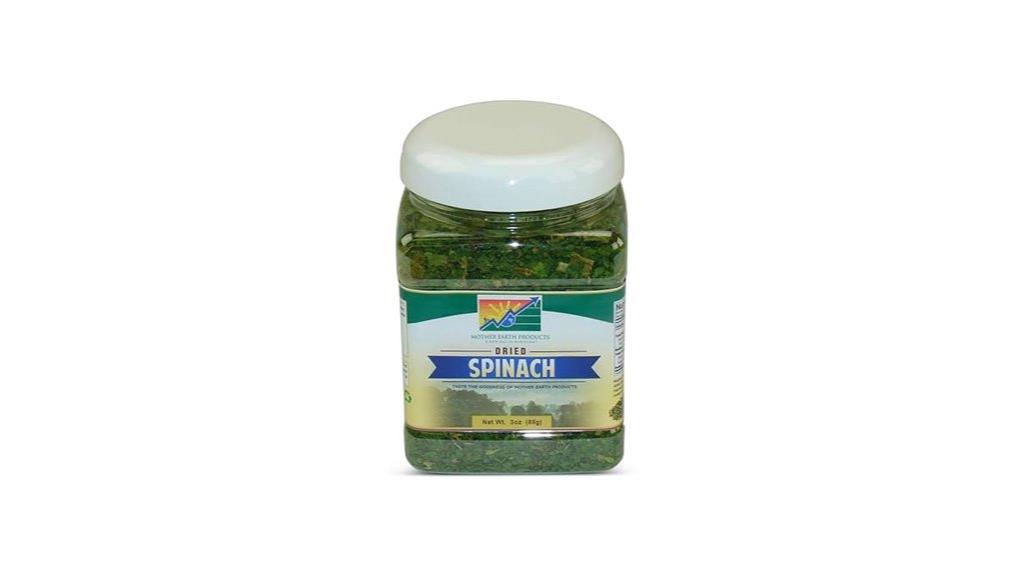
The Mother Earth Products Dehydrated Spinach Jar is perfect for anyone looking to add a nutritious boost to their meals without the hassle of fresh produce. Packed in a quart-sized plastic jar, it’s non-GMO and gluten-free, making it a great pantry staple. I love how it maintains the nutritional value of fresh spinach without any additives. The versatility is incredible—I toss it into sauces, soups, and even blend it into meatloaf for that “stealth nutrition.” Plus, with a shelf life of up to 25 years, it saves space and time. It’s a fantastic way to enjoy spinach anytime!
Best For: Individuals and families looking for a convenient, long-lasting source of nutrition that can easily enhance meals without the waste of fresh produce.
Pros:
- Non-GMO and gluten-free, suitable for a variety of dietary needs.
- Versatile usage in a wide range of recipes, from sauces to meatloaf.
- Long shelf life of up to 25 years, making it economical and space-saving.
Cons:
- Dried pieces may not resemble the texture of fresh spinach leaves.
- Flavor and color are good, but some consumers may prefer the taste of fresh spinach.
- Larger dried pieces could improve the texture in certain dishes.
Z Natural Foods Organic Spinach Powder (1 lb)
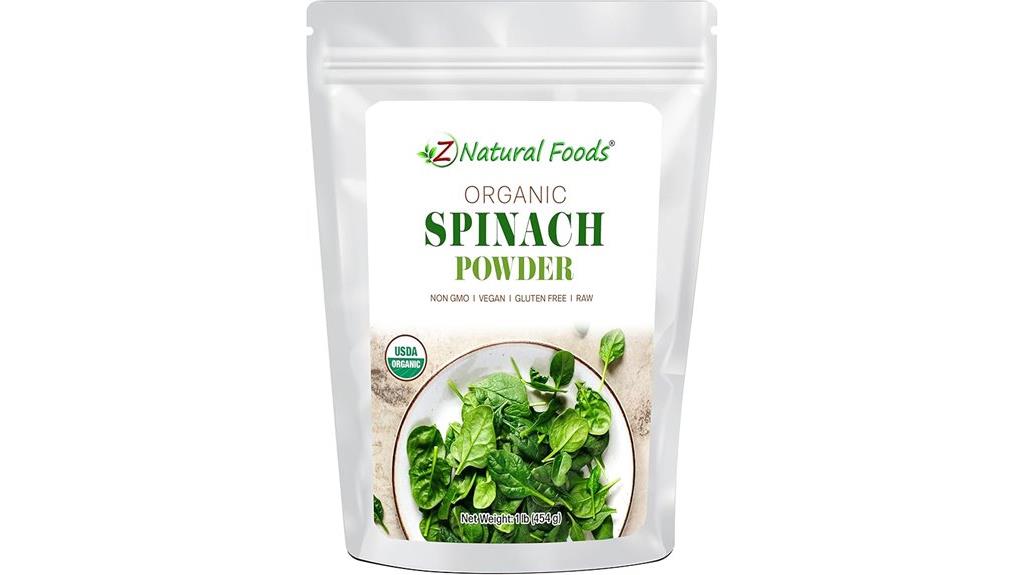
Z Natural Foods Organic Spinach Powder (1 lb) is an excellent choice for health-conscious individuals looking to boost their nutrition effortlessly. This pure, nutrient-dense powder packs essential vitamins, minerals, and antioxidants into one tablespoon, supporting my immune health and energy levels. Plus, it’s USDA Organic, non-GMO, gluten-free, and vegan—perfect for anyone conscious about what they consume. I love adding it to smoothies or soups, and it blends seamlessly without fuss. While I’ve heard concerns about potential California warning labels, my experience has been positive, enhancing my meals and daily nutrition without hassle. It’s a fantastic alternative to fresh spinach!
Best For: Health-conscious individuals seeking a convenient way to enhance their nutrition with organic and nutrient-dense ingredients.
Pros:
- Nutrient-rich: Packed with essential vitamins, minerals, and antioxidants to support overall wellness.
- Versatile usage: Easily blends into various dishes like smoothies, soups, and sauces without fuss.
- High-quality certification: USDA Organic, non-GMO, gluten-free, and vegan, ensuring clean ingredients.
Cons:
- Messy handling: The fine powder can lead to messiness during use if not careful.
- California warning concern: Potential cancer risk warning may deter some consumers.
- Limited fresh alternative: While convenient, it may not fully replace the taste and texture of fresh spinach.
Heirloom Viroflay Spinach Seeds for Planting (500 Seeds)

Heirloom Viroflay Spinach Seeds, with their impressive germination rate and premium quality, are perfect for both novice and experienced gardeners alike. Each packet contains 500 non-GMO seeds, ensuring you have plenty to plant. I love that they thrive in a range of temperatures, from 45°F to 75°F, making them ideal for spring and fall planting. The large leaves are not only tender but also pack a nutritious punch, perfect for salads and smoothies. Plus, their waterproof packaging keeps them fresh. With a quick germination time, I’ve found these seeds to be a reliable choice for my garden.
Best For: Heirloom Viroflay Spinach Seeds are best for both novice and experienced gardeners looking for a high-quality, nutritious spinach variety to grow in their home gardens.
Pros:
- Abundant yield of large, tender leaves suitable for a variety of culinary uses.
- Quick germination within 7-14 days, making them a reliable choice for planting.
- Non-GMO and USA-grown seeds ensure quality and sustainability.
Cons:
- Some customers suggest the packaging would benefit from a resealable option for better storage.
- Requires specific soil conditions (loam) and full sun exposure, which may not suit all garden environments.
- Limited to USDA Hardiness Zones 2-10, restricting use in colder or hotter climates.
Micro Ingredients Organic Spinach Powder (1 Pound)

For health-conscious individuals looking to boost their nutrient intake effortlessly, Micro Ingredients Organic Spinach Powder is an excellent choice. This freeze-dried powder, made from whole leaves, is non-GMO, vegan-friendly, and sustainably grown in the US. Packed with immune-boosting vitamins and essential minerals, it’s a powerhouse of nutrition. I love how easy it is to incorporate—just a scoop in my smoothies or sprinkled on meals. It mixes well without any grit, and I appreciate the fresh taste. Plus, it’s gluten-free and free from additives, making it a safe, convenient option for daily use.
Best For: Health-conscious individuals seeking a convenient way to boost their nutrient intake without the hassle of fresh greens.
Pros:
- Rich in essential vitamins and minerals, supporting immune health and overall wellness.
- Easy to incorporate into various recipes, such as smoothies and meals, with a pleasant taste and no grit.
- Non-GMO, vegan-friendly, gluten-free, and free from additives, making it a safe choice for diverse dietary needs.
Cons:
- May require a scoop for accurate measurement, which could be inconvenient for some users.
- Potentially higher price point compared to regular spinach, depending on availability and location.
- Some individuals may prefer fresh greens over powdered options for taste and texture.
Survival Garden Seeds Spinach Seed Collection (3 Packets)
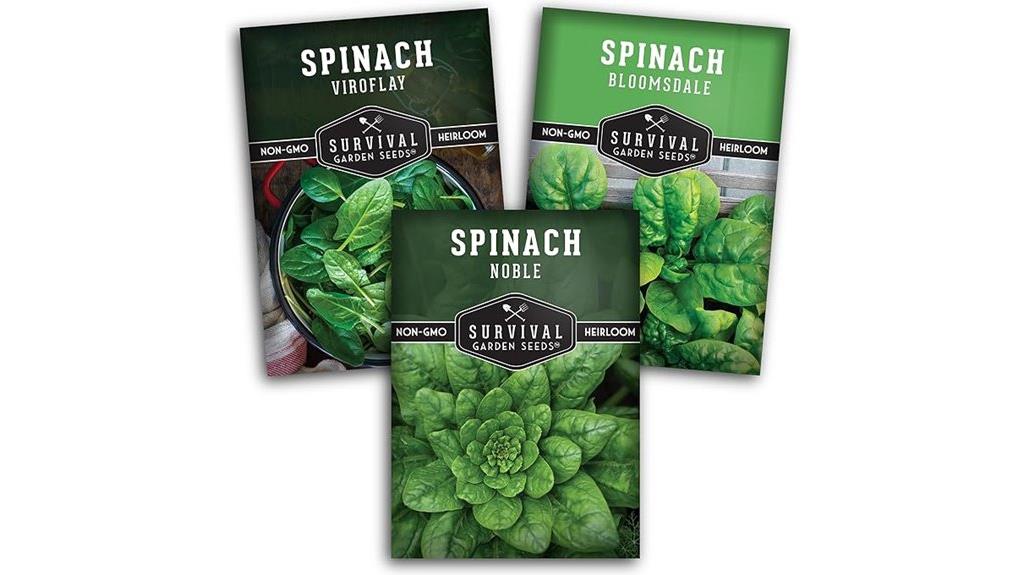
If you’re looking to cultivate a thriving garden with fresh, nutritious spinach, the Survival Garden Seeds Spinach Seed Collection is perfect for you. This collection features three amazing varieties: Viroflay, Noble Giant, and Bloomsdale. Each packet includes non-GMO, heirloom seeds with growing instructions and tips for saving seeds. I appreciate the quick growth of Viroflay and the rich flavor of Noble Giant. Plus, Bloomsdale’s cold hardiness makes it ideal for fall sowing. With a 90% germination rate, I’ve had great success. These seeds are a fantastic choice for any gardener wanting to enjoy delicious spinach year-round!
Best For: Gardeners looking for a variety of non-GMO, heirloom spinach seeds that thrive in different conditions and seasons.
Pros:
- High germination rate of around 90%, ensuring successful growth.
- Offers a diverse selection of spinach varieties (Viroflay, Noble Giant, Bloomsdale) for versatile culinary uses.
- Suitable for both outdoor and indoor gardening, adapting well to various environments.
Cons:
- Some customers reported issues with germination, indicating variability in seed performance.
- Requires specific growing conditions such as full sun and sandy soil, which may not be available to all gardeners.
- Limited to spinach varieties, which may not meet the needs of gardeners seeking a broader range of vegetables.
Del Monte Canned Fresh Cut Chopped Spinach, 13.5 Ounce (Pack of 12)
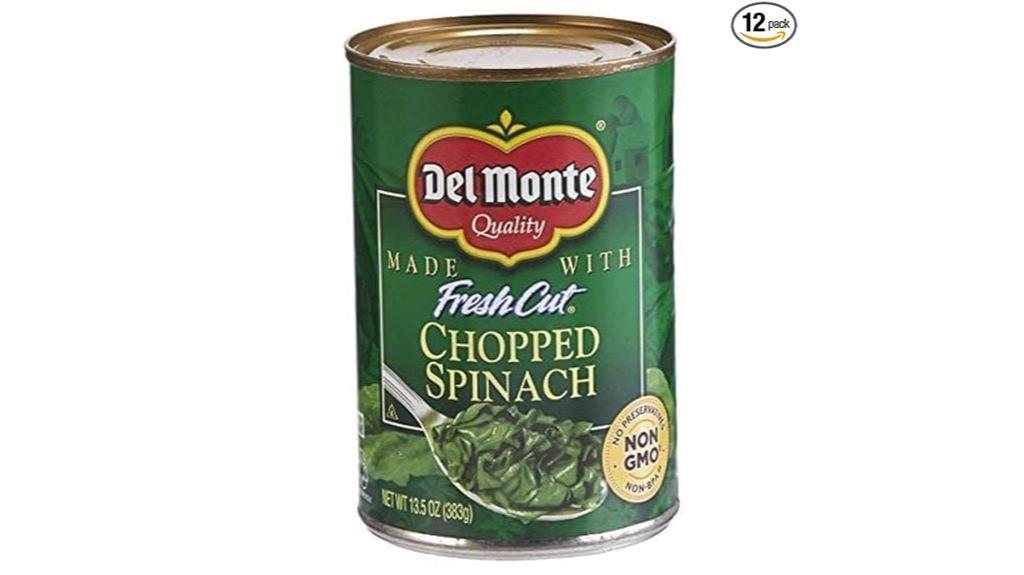
Del Monte Canned Fresh Cut Chopped Spinach, 13.5 Ounce (Pack of 12) is an ideal choice for anyone seeking a quick, nutritious addition to their meals without the hassle of washing and prepping fresh greens. I love that it’s picked at peak freshness and packed rapidly, ensuring maximum flavor and nutrition. With just spinach, water, and sea salt, it’s non-GMO and free of preservatives. I can easily use it in various dishes—from pasta to grilled chicken. Plus, its long shelf life makes it a perfect pantry staple for busy days or emergencies. It’s a reliable backup for fresh spinach!
Best For: Busy individuals or families seeking a quick, nutritious vegetable option without the prep work of fresh greens.
Pros:
- Convenient: Ready to use straight from the can, saving time on meal preparation.
- Nutritious: Non-GMO, free of preservatives, and retains essential vitamins and minerals.
- Versatile: Can be incorporated into a variety of dishes, enhancing meals with minimal effort.
Cons:
- Sodium Content: Some users may find the sodium level high, requiring rinsing before use.
- Texture: Canned spinach may not have the same texture as fresh spinach, which some may prefer.
- Limited Flavor Options: The simple ingredient list may not appeal to those looking for more complex flavors.
New Zealand Spinach Seed for Planting – Non-GMO Heirloom Variety

New Zealand Spinach seeds are perfect for gardeners seeking a resilient, low-maintenance crop that thrives in warmer climates. I love that this non-GMO heirloom variety, Tetragonia Tetragonoides, is heat tolerant and doesn’t bolt like regular spinach. It flourishes in full sun and even handles drought conditions well. Plus, it’s hydroponic-friendly, making it ideal for indoor or container gardens. With its continuous supply of nutritious greens, I can enjoy fresh leaves year-round. The seeds come with helpful planting instructions and tips for seed-saving, making it easy for gardeners of all experience levels to succeed.
Best For: Gardeners looking for a resilient, heat-tolerant leafy green that thrives in warmer climates and drought conditions.
Pros:
- Hydroponic-friendly and suitable for indoor or container gardening.
- Continuous supply of nutritious greens year-round with regular harvesting.
- Comes with planting instructions and seed-saving advice, making it easy for all experience levels.
Cons:
- May not perform as well in cooler climates compared to regular spinach.
- Limited availability of varieties beyond the heirloom type.
- Requires full sun exposure, which may not be suitable for all gardening spaces.
20th Street Products Popeye Chopped Spinach (3 Pack)
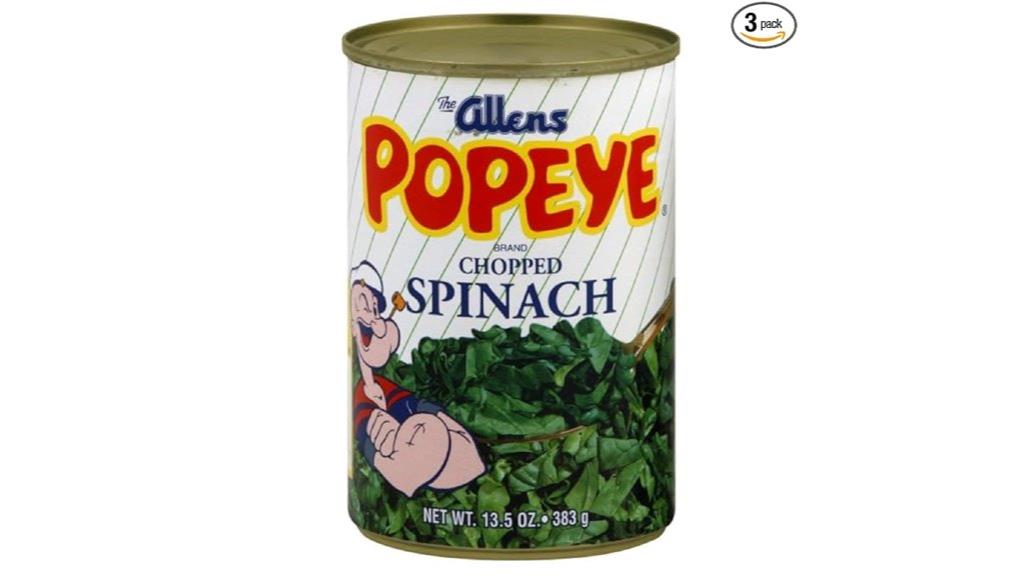
20th Street Products Popeye Chopped Spinach (3 Pack) is perfect for anyone seeking a quick and nutritious addition to their meals. This all-natural, preservative-free spinach comes in convenient cans, ensuring I always have a healthy option on hand without worrying about spoilage. With its low fat and rich iron content, it’s a guilt-free choice. I love using it in Mediterranean dishes, quiches, or even dips like spinach and artichoke. The tender, mildly sweet flavor enhances my pasta dishes beautifully. Plus, customers rave about its quality and taste, making it a staple in my kitchen.
Best For: Busy individuals and families looking for a convenient, nutritious, and versatile vegetable option to enhance their meals.
Pros:
- All-natural and preservative-free, ensuring a healthier choice.
- Rich in iron and low in calories, making it a guilt-free addition to any diet.
- Versatile culinary uses, perfect for a variety of dishes from quiches to pasta.
Cons:
- Canned texture may not appeal to everyone, especially those who prefer fresh vegetables.
- Limited serving size per can, which may not be sufficient for larger families or gatherings.
- Flavor may vary slightly, depending on individual taste preferences.
Sow Right Seeds Spinach Seed Collection for Planting

If you’re looking to grow your own nutrient-dense leafy greens, the Sow Right Seeds Spinach Seed Collection is an excellent choice for home gardeners. This collection features Viroflay, Malabar, and Bloomsdale varieties, packaged in three generous packets. I appreciate that these are non-GMO heirloom seeds, ensuring safety and sustainability. They thrive in various settings, from greenhouses to containers, and offer clear germination instructions. While some users report mixed germination rates, I’ve found soaking seeds overnight and refrigerating them helps. Overall, this collection offers a fantastic opportunity to enjoy flavorful spinach while supporting an environmentally friendly operation.
Best For: Home gardeners looking to grow a variety of nutrient-dense spinach in sustainable and environmentally friendly ways.
Pros:
- Non-GMO heirloom seeds promote safety and sustainability.
- Versatile growth options, suitable for greenhouses, raised beds, and containers.
- Clear germination instructions and customer support available for assistance.
Cons:
- Mixed reviews on germination rates, with some users experiencing lower success.
- Minor packaging issues reported by a few customers.
- Requires specific preparation techniques for optimal results.
Food to Live Spinach Powder, 1 Pound
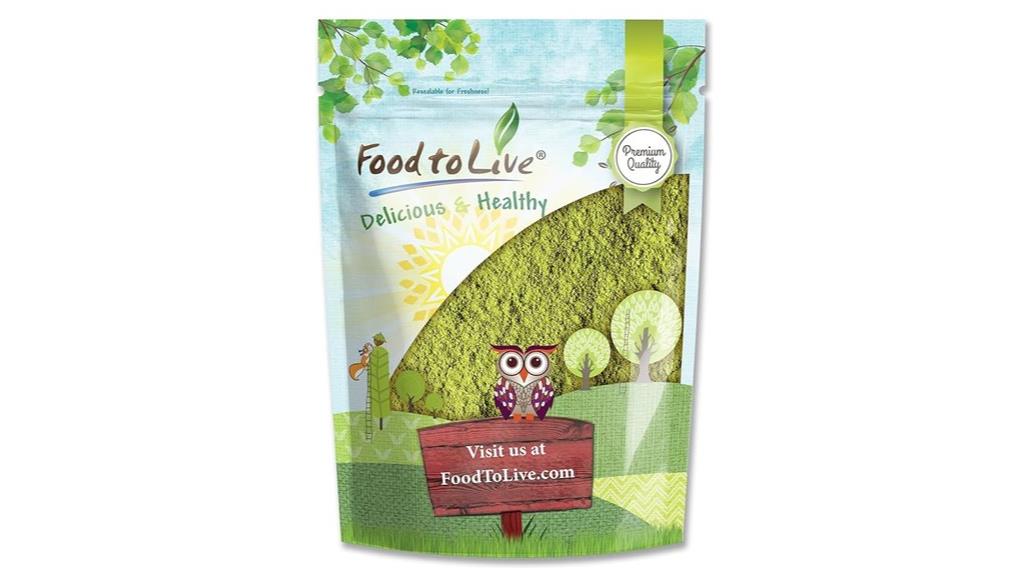
Food to Live Spinach Powder, 1 Pound, is an excellent choice for anyone looking to boost their nutritional intake without the hassle of fresh produce. This finely ground, dehydrated spinach is vegan, kosher, and packed with essential vitamins and minerals, including fiber, vitamin A, and iron. I love using it in smoothies, baked goods, and even soups for added nutrition. While its milder taste blends well, I’ve noticed that overusing it can lead to a slightly bitter flavor. Just keep an eye on the serving size, and you’ll enjoy the benefits without overwhelming your dishes.
Best For: Health-conscious individuals looking to enhance their diets with a convenient and nutritious ingredient.
Pros:
- Rich in essential vitamins and minerals, including fiber, vitamins A, C, and iron.
- Versatile ingredient that easily incorporates into various recipes like smoothies, baked goods, and soups.
- Milder taste compared to fresh spinach, making it easier to blend into meals without overpowering flavors.
Cons:
- Not organic and sourced from China, which may raise concerns for some consumers.
- Some users report issues with flavor intensity and bitterness if used excessively.
- Safety warnings related to California Proposition 65 have been noted, causing potential concerns about product safety.
BulkSupplements Organic Spinach Extract Powder (100g)

For anyone looking to boost their nutritional intake while managing their appetite, BulkSupplements Organic Spinach Extract Powder (100g) stands out as an ideal choice. This gluten-free supplement packs 500mg per serving and is rich in essential vitamins and minerals from spinach leaves. I love how it helps control hunger and supports digestive health. You can easily mix it into smoothies or coffee without a strong aftertaste. While some users mention the taste can be overpowering, it’s versatile enough to accommodate various preferences. Plus, the quality assurance through third-party testing gives me confidence in its effectiveness and safety.
Best For: Individuals seeking to enhance their nutritional intake while managing appetite and supporting digestive health.
Pros:
- Easy to mix into beverages like smoothies or coffee without a strong aftertaste.
- Rich in essential vitamins and minerals, aiding overall health and wellness.
- Manufactured under cGMP standards and undergoes third-party testing for quality assurance.
Cons:
- Some users find the spinach flavor too strong when mixed with certain foods.
- A few people have reported side effects, such as constipation.
- There are occasional concerns regarding packaging issues.
TKE Farms Viroflay Spinach Seeds for Planting

TKE Farms Viroflay Spinach Seeds are an excellent choice for home gardeners looking to grow abundant, nutrient-rich greens with minimal effort. With over 250 heirloom, non-GMO seeds, I find these fast-growing plants produce giant, tender leaves that are perfect for salads and smoothies. They thrive in USDA zones 3-9 and are cold-hardy, making them resilient. I recommend planting them in well-drained soil, about ¼ inch deep, and ensuring they get full sun to partial shade. By succession planting every 2-3 weeks, I enjoy a continuous harvest of these nutritious greens, packed with iron and vitamins A and C.
Best For: Home gardeners seeking a robust and easy-to-grow spinach variety that yields nutritious greens throughout the growing season.
Pros:
- Fast-growing variety that produces giant, tender leaves in as little as 30 days.
- Cold-hardy and resilient, suitable for a wide range of USDA zones (3-9).
- Rich in nutrients, providing excellent health benefits with high levels of iron, vitamins A & C.
Cons:
- Requires consistent moisture to ensure optimal growth and prevent bolting.
- May not thrive in hot temperatures, limiting growing seasons in warmer climates.
- Needs space for proper plant spacing (6-8 inches apart), which may be a constraint in smaller gardens.
500+ Kong Xin CAI Vegetable Seeds for Water Spinach Kangkong
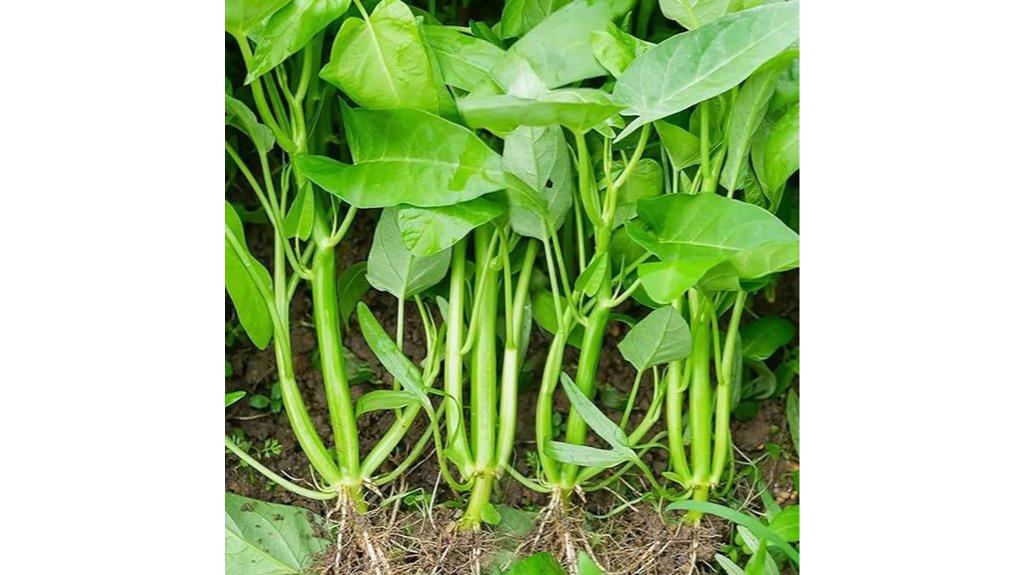
Kong Xin CAI Vegetable Seeds for Water Spinach Kangkong are perfect for both novice and seasoned gardeners looking to cultivate a nutritious and flavorful green. With over 500 seeds, these non-GMO varieties thrive in rich, soggy soil and can even grow in standing water. I’ve found their mild taste and tender leaves make them a delightful addition to any meal. They germinate quickly, usually within 5-7 days, under ideal temperatures of 60°F – 80°F. Just remember to keep the soil moist and provide full sun. Despite mixed reviews on germination, I’ve always enjoyed their robust growth, especially in summer.
Best For: Beginner and experienced gardeners looking to grow nutritious and flavorful water spinach in both indoor and outdoor settings.
Pros:
- Non-GMO seeds suitable for various planting environments.
- High germination rate of 95% in ideal conditions, typically sprouting within 5-7 days.
- Tender leaves with a milder taste than traditional spinach, enhancing meal flavors.
Cons:
- Mixed reviews regarding seed viability, with some customers experiencing low germination rates.
- Requires consistent watering (2-3 times daily) and specific soil conditions, which may be demanding for some gardeners.
- Not shade-tolerant, limiting planting options in less sunny areas.
Factors to Consider When Choosing Spinach Production

When I think about starting spinach production, I consider several key factors to set myself up for success. Choosing the right seed variety, ensuring quality soil and nutrients, and timing my planting season are essential steps. I also pay attention to watering methods and pest management to keep my crop healthy and thriving.
Seed Variety Selection
Choosing the right seed variety is vital for successful spinach production. I always look for heirloom or open-pollinated varieties since they allow me to save seeds and maintain genetic diversity. It’s important to evaluate the germination rate and ideal growing conditions—temperature and soil type matter for maximizing growth and yield. Varieties like Viroflay and Bloomsdale are my go-to choices because they resist bolting and thrive in cooler temperatures, making them adaptable to various climates. Additionally, I verify the seeds are suited for my local USDA hardiness zone. Finally, I assess leaf size and flavor; some varieties are perfect for fresh salads, while others work wonderfully in cooking or smoothies.
Soil and Nutrient Quality
Soil quality and nutrient levels are fundamental for spinach production, especially since I want to maximize my harvest. I’ve found that spinach thrives in well-drained, fertile loam soil, which holds moisture while providing necessary nutrients. Keeping the soil pH between 6.0 and 7.0 is essential, as it promotes nutrient availability. I regularly test my soil to guarantee it’s rich in nitrogen and potassium, critical for vigorous growth. To boost nutrient content, I incorporate organic matter like compost or well-rotted manure, which also improves soil structure. Finally, I make sure to water adequately, particularly during dry spells, since spinach is sensitive to drought stress that can hurt leaf quality and growth rates.
Planting Season Timing
After confirming the soil is rich and well-prepared, I focus on the timing for planting spinach, which can greatly impact my harvest. I typically plant in early spring or fall, but in milder climates, I can even plant during winter. I’ve learned that spinach seeds germinate best at temperatures between 60°F and 70°F, so I always check the weather before planting. Being a cold-hardy crop, spinach thrives in USDA Hardiness Zones 2-10, which helps me decide when to plant. I also practice succession planting every 2-3 weeks during the growing season to confirm a continuous harvest. This timing not only maximizes my productivity but also keeps my garden vibrant and full of fresh spinach.
Watering and Irrigation Methods
While I know that proper watering is essential for a successful spinach crop, I also recognize that the method I choose can make a significant difference. Spinach thrives with consistent moisture, so I aim for about 1 to 1.5 inches of water each week, adjusting based on soil type and weather. I find drip irrigation particularly effective, as it delivers water directly to the root zone, minimizing waste and reducing fungal disease risks. I keep a close eye on soil moisture, ensuring it stays evenly moist but not waterlogged, since too much water can lead to root rot. To stay on top of this, I often use the finger test or a moisture meter to maintain ideal conditions for my spinach.
Pest and Disease Management
Managing pests and diseases is vital for a thriving spinach crop. I make sure to implement crop rotation and diversify my planting to minimize the risk of pest and disease buildup. Regular monitoring for common pests like aphids and leaf miners helps me catch issues early, preventing significant damage to my spinach. I also practice integrated pest management (IPM), using beneficial insects and organic pesticides to keep pest populations in check while protecting the environment. It’s important to establish proper sanitation measures, like removing infected plants and debris, to stop diseases such as downy mildew and Fusarium wilt from spreading. Finally, I maintain ideal soil health through good drainage and nutrient management, which lowers the risk of pests and diseases affecting my spinach.
Harvesting Techniques and Timing
When it comes to harvesting spinach, timing and technique are essential for maximizing both yield and quality. I usually start harvesting around six weeks after seeding, when the leaves are about 4 to 6 inches long. I prefer picking the outer leaves, which encourages continuous growth and keeps the plants from becoming bitter. The best time to harvest is in the morning, when the leaves are crisp and tender. I also keep an eye on the weather; if temperatures exceed 75°F, my spinach is at risk of bolting, so I make certain to harvest promptly. Regularly monitoring and harvesting guarantees I enjoy fresh, flavorful spinach throughout the growing season.
Frequently Asked Questions
What Is the Best Time to Plant Spinach Seeds?
I’ve found that the best time to plant spinach seeds is in early spring or late summer. When spring arrives, I usually wait until the soil temperature reaches about 40°F. If I plant in late summer, I aim for a couple of months before the first frost. This timing helps me enjoy fresh spinach just when I’m craving those vibrant greens. Don’t forget to keep the soil moist for ideal growth!
How Much Sunlight Does Spinach Need for Optimal Growth?
When it comes to sunlight, spinach practically demands a VIP pass! It thrives best with about six hours of direct sunlight each day. Too little, and it might sulk like a spoiled child; too much, and it risks wilting under pressure. I’ve found that partial shade during the hottest part of the day can keep my spinach vibrant and happy. So, make sure your leafy greens bask in that glorious sun just enough!
What Pests Commonly Affect Spinach Plants?
I’ve noticed that spinach plants can attract a few common pests. Aphids are one of the biggest culprits, sucking sap from the leaves and stunting growth. You might also encounter leaf miners, which create unsightly tunnels in the leaves. Additionally, slugs and snails can munch on young plants. To protect my spinach, I often check for these pests regularly and use organic methods to keep them at bay.
How Often Should Spinach Be Watered During the Growing Season?
Watering spinach can feel like trying to tame a wild beast! I usually water my spinach every 2-3 days during the growing season, ensuring the soil stays consistently moist but not soggy. On hotter days, I check more frequently. It’s all about finding that sweet spot where your spinach thrives. Trust me, keeping an eye on moisture makes a world of difference in those delicious, vibrant leaves that we all love!
What Are the Signs of Nutrient Deficiency in Spinach Plants?
When I notice my spinach plants struggling, I look for signs of nutrient deficiency. Yellowing leaves often indicate a lack of nitrogen, while purpling can signal phosphorus deficiency. If the leaves appear stunted or develop a mottled pattern, it might mean they need more iron or magnesium. I always keep an eye on these symptoms, as addressing nutrient deficiencies promptly helps my spinach thrive and guarantees a bountiful harvest.
Conclusion
In my journey to grow spinach, I’ve discovered that choosing the right seeds, nurturing the soil, and embracing organic methods transform my garden into a thriving haven. With each vibrant leaf I harvest, I’m reminded of the joy that comes from nature’s bounty. Whether it’s planting heirloom varieties or experimenting with dehydrated options, the satisfaction of fresh spinach fills my kitchen and my heart. So let’s dig in, sow our seeds, and savor the rewards of our labor together!
